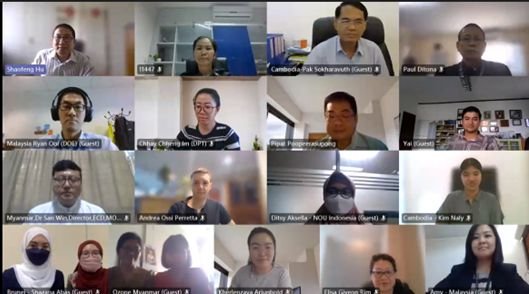Forty-seven participants (male 27, female 20) from National Ozone Units (NOUs) and Customs authorities of countries in the Southeast Asia (SEA) Network gathered virtually on 10 May for a thematic meeting on the Adoption and Implementation of ASEAN Harmonized Tariff Nomenclature 2022 (AHTN2022) for HFCs (hydrofluorocarbons) to enhance monitoring, reporting, verification and enforcement (MRVE) of national HFC licensing systems.
HFCs as well as related substances, hydrochlorofluorocarbons (HCFCs), are commonly used across the globe as refrigerants in air conditioners and refrigerators, among other applications. When released into the atmosphere, both contribute to climate change and HCFCs also deplete the Earth’s stratospheric ozone layer. Both gases are controlled under the international treaty known as the Montreal Protocol, under which countries are working to eliminate HCFCs (phase-out) and reduce HFCs (phase-down). The Montreal Protocol controls the import and export of the controlled substances and thus Customs agencies play a vital role in ensuring compliance with the treaty.
The Association of Southeast Asian Nations (ASEAN) adopted the regional harmonized system (HS) code for trade known as the “ASEAN Harmonized Tariff Nomenclature (AHTN)” which is to be implemented from 1 January 2022, only assigned specific 8-digit HS codes for a few HFC substances such as R-404A, R-410A and R-507A. It is therefore critical for the SEA Network countries, which are ASEAN members, to explore the possibility of specifying HS codes for the other most commonly-used HFCs and blends under the structure of AHTN 2022.
8242During the meeting, participants exchanged views and experiences on how HFCs and mixtures can be accurately recorded in the customs system. Countries with the HS code system that can accommodate additional digits to the AHTN 2022 were urged to assign additional digits. Countries that exactly follow the 8-digit AHTN 2022 code system need to use additional mechanisms to capture trade statistics for the different types of HFCs and mixtures, such as the use of Chemical Abstracts Service (CAS) numbers to identify specific HFCs; or ensure proper declaration of refrigerants by indicating their assigned ASHRAE (refrigerant) numbers in the description of commodities, etc.
In the case of Cambodia, Mr. Pak Sokharavuth, the National Ozone Officer, said “currently Cambodia is using 8-digit HS codes as per AHTN 2022, which does not allow individualizing HS codes for most commonly-used HFCs in the country. From discussions and experiences of other countries, we have learned from this meeting useful information and practical guide as food for thought for Cambodia’s National Ozone Unit to further collaborate with the General Department of Customs and Excise to determine an approach to capture trade statistics of HFCs and mixtures”.
The meeting also touched upon integrated approaches, i.e. identifying and integrating the HCFC/HFC control work into various existing workstreams of the customs authority to further strengthen the national MRVE system to effectively manage HCFC/HFCs trade control. It was agreed that UNEP would promote the adoption of AHTN 2022 for HFCs and explore the integration initiative with Cambodia, the Chair of ASEAN in 2022, to further enhance regional management.
The joint virtual meeting was organized as part of UNEP OzonAction CAP’s approved workplan for 2022 as part of its role as an Implementing Agency of the Montreal Protocol’s Multilateral Fund.
05 June 2022
Southeast Asia Network Countries explore ways to strengthen HFC licensing systems
Related news
Scientists urge continued use of OECD chemical definition for PFASs
A group of scientists specializing in per- and polyfluoroalkyl substances (PFASs) has issued a statement supporting the current chemical definition of PFASs established by the Organisation for Econ...
today
REFCOM registers 9,000th member amid regulatory and market pressures
REFCOM, the UK’s F-Gas certification body, has reached 9,000 members, marking a new milestone in the refrigeration, air conditioning and heat pump (RACHP) sector. The growth reflects increasing dem...
24 Jun 2025
Australia marks World Refrigeration Day with focus on Cool Skills
Australia’s HVACR industry celebrates World Refrigeration Day (WRD) on June 26, highlighting the critical role of refrigeration in everyday life. This year’s theme, Cool Skills, recognises the indi...
26 Jun 2025
HARDI and AHRI Challenge New York HFC Rule in State Court
Industry groups cite procedural flaws and conflict with federal AIM Act.
Heating, Air-conditioning & Refrigeration Distributors International (HARDI) and the Air-Conditioning, Heatin...
10 Apr 2025
ASHRAE Updates Refrigerant Designations and Safety Classifications
The May 2025 UNEP/ASHRAE factsheet outlines new refrigerant numbers and safety classifications under ANSI/ASHRAE Standards 34 and 15, including flammability, toxicity, and GWP data.
ASHRAE has...
09 May 2025
Arkema to distribute lower-GWP refrigerants under Forane brand
Arkema has announced an expansion of its refrigerant portfolio through a commercial agreement with Honeywell International Inc. The company will offer a range of lower global warming potential (GWP...
20 May 2025
